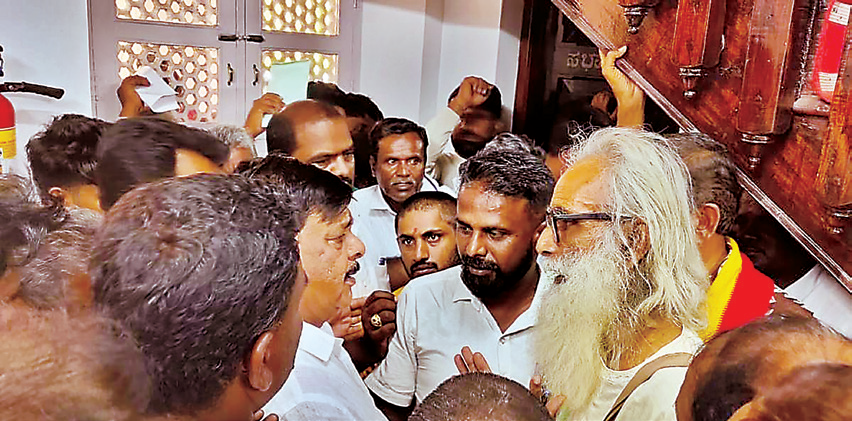
Why coastal Karnataka upset over removal of Guru’s chapters
By Sona Christy
Mangaluru: The alleged removal of chapters on Sri Narayana Guru from the High School textbooks has stirred a hornet’s nest in Karnataka.
Educationists, social activists, and political leaders have urged the government to retract the decision. The heat is particularly felt in coastal Karnataka, where Sri Narayana Guru has been revered as a messiah by the downtrodden groups, especially by the Billava community.
Early this year, Mangaluru and Udupi had witnessed a series of protests after the Centre rejected Guru’s tableau from the Republic Day Parade. Scores of followers of Guru trooped into the street draped in Yellow and organised Swabhimana Jatha.
Narayana Guru was a philosopher, spiritual leader, and social reformer from Kerala who led a movement against casteism and untouchability. Guru had played a key role in abolishing casteism in coastal Karnataka too by consecrating the Gokarnanatheshwara Temple in Kudroli in 1912 when caste-discrimination was at its peak.
No temple entry
There was a time when Billava community members - toddy tappers by profession - were suppressed by the upper-caste communities and treated as untouchables. Hence they could not set foot in the local temples.
In this scenario, Billava community leader Sahukar Koragappa had visited Shri Narayana Guru at Kerala in 1908 along with other community elders and sought his guidance to build a temple. What angered Koragappa was the humiliation he suffered after he entered the Gokarna Temple.
When upper-caste people found out that he was from the Billava community, they collected money from him to cleanse (punyaham) the temple. When he described his ordeal to Guru, the latter said: “Why did you go to Gokarna, I would bring the temple to you.”
Guru kept his promise, and in 1912 he installed a Shivalinga, consecrated it and named it Gokarnanatheshwara temple.
The temple treasurer, Padmaraj R said idols of Ganapathy, Lord Subramanya, Goddess Annapoorneshwari and other deities were installed as per Guru’s advice.
It is unthinkable to separate his guidance and speak of progress of oppressed communities anywhere in the globe,” former executive member and spokesperson of Gokarnanatheshwara Temple and BJP leader Harikrishna Bantwal said.
From its humble beginnings, Gokarnatheshwara temple has grown into the biggest temple in Mangaluru after its renovation and inauguration in 1991 by Prime Minister Rajiv Gandhi. “Gokarnanatheshwara Temple now attracts lakhs of worshippers every year,” Padmaraj said.
Speaking to News Trail, former Mangalore south MLA, JR Lobo said Sri Narayana Guru’s preaching on one God, one religion resonated among the downtrodden communities. “His teachings are relevant even today. There must be a concerted effort in the mainstream to ensure that lessons preached by the likes of Narayana Guru, Basavanna and Thanthai Periyar reached everyone through formal and informal educational curriculum. Only then broadminded citizenry can evolve,” he said.
“Narayana Guru’s views against casteism, education, social reform, made him the community leader. He is amongst those social reformers who has etched a place in the hearts of every person in the coastal region,” he added.
Political parties react
Reacting to the government decision to delete Guru’s chapter, Communist Party of India (Marxist) leader Sunil Kumar said Narayana Guru’s fight against casteism reformed Billava and many other communities. “His progressive guidance and teaching have transformed the community. If we need more reformists, their lives and teachings must be taught,” he said.
Sharan Pumpwell, Secretary of Vishwa Hindu Parishad, Mangaluru Vibhag, claimed the removal of chapters of Sri Narayana Guru from High school textbooks is not true. “The new textbook has not yet been published. Even if it is a true statement, Guru’s ideologies need to be a part of the textbook and we would strongly oppose the state government otherwise,” he said.
 English daily published in Bengaluru & Doha
English daily published in Bengaluru & Doha






